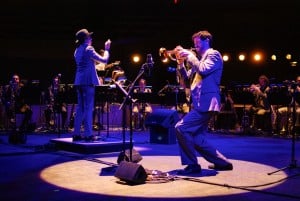
A grainy loudspeaker repeats the same numbers over and over. People in trenchcoats cluster around a single, harsh light, huddled together and focusing intently. The rest take their seats onstage — and the Secret Society begins to perform.
This past Friday, creator Darcy James Argue brought his 18-member ensemble, the Secret Society, to Bing Concert Hall in a performance of his nonfiction work, “Real Enemies.” As audience members trickled in, they observed a strange setup onstage: a semicircle of chairs, a drum set, speakers and a ring of lights on the stage’s far wall. This strangeness continued throughout the night, from the first dissonant notes to the patches each member of the Secret Society wore on their chests. According to the Argue, “Real Enemies” is a nonfiction work that explores the “mixture of factual truth, deduction, intuition, supposition and imagination” surrounding conspiracy theories. He certainly captured their essence over the course of the mysterious, unorthodox performance.
The 70-plus minute program was performed in a single sitting, broken down into 13 different chapters with titles like “The Enemy Within” and “Silent Weapons for Quiet Wars.” Transitions between moods varied widely — sometimes the only sign was a change in tempo, whereas at other times the lighting changed from a single harsh spotlight to a ring of eerie blue lights. Argue himself did not join his ensemble until halfway through the first chapter, “You Are Here.” His late entrance only added to the sense of mystery, along with his popped collar, fedora and lack of acknowledgement for the audience.
The most captivating piece of the night was the third chapter, “Dark Alliance,” the first to play with different lighting effects. The mood began under vivid purple lighting onstage and polka dot patterns on the acoustic walls of Bing, as well as indistinct speech from the loudspeakers. The sound itself was less urgent than the previous chapter, with a more relaxed beat in the drums accompanied by jazzy, offbeat chords. Though the music took on a less chaotic mood than in previous chapters, the lighting made up for it; the colors switched frequently from purple to red, and the polka dot lights would occasionally travel all over the room, sometimes shining on the audience. However, it was the ending that really stood out in terms of sound and visuals. A run of detached notes in unison, increasing in volume and perfectly executed, was accompanied by flashes and, on the final note, full-power lighting from the ring of lights, briefly blinding the audience.
Argue’s performance of “Real Enemies” was incomplete, as the visual component that goes along with it is not yet finished (it will premier in a month and a half in New York.) It’s hard to imagine adding another element into what is already a complex and chaotic performance, complete with roving lights and historical recordings alongside contemporary music. At times, the Secret Society sounded more noisy than musical, perhaps capturing the messy nature of paranoia. Regardless, Argue definitely left the audience with a little more confusion and a lot more curiosity about conspiracy theories.
Contact Serena Wong at serenaw ‘at’ stanford.edu.